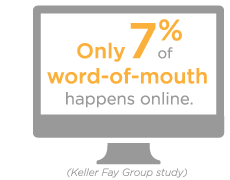What motivates people to buy a product, service or offering? It turns out that effectively engaging with customers requires getting emotional about your brand and with your branding—literally. When feelings are at the core of marketing messages, they are more relevant to customers—and in turn, using emotions motivates them to believe in and buy your brand.
 According to Jonah Berger, author of Contagious: Why Things Catch On (Simon & Schuster, 2013), “focusing on feelings” allows brands to tap into customers’ emotions and make them care about your brand. Berger observes that when people care about something, they will talk about it with their friends, colleagues, and others; this ‘word-of-mouth’ marketing is one of the most effective and powerful forms of marketing.
According to Jonah Berger, author of Contagious: Why Things Catch On (Simon & Schuster, 2013), “focusing on feelings” allows brands to tap into customers’ emotions and make them care about your brand. Berger observes that when people care about something, they will talk about it with their friends, colleagues, and others; this ‘word-of-mouth’ marketing is one of the most effective and powerful forms of marketing.
 Effectively using emotions to market your product or service doesn’t need to incorporate visuals of people sitting around a campfire singing “kum bay ah” or messages that are overly optimistic or happy—studies have shown that both positive and negative emotions may be used to motivate people. In the diagram above, various emotions have been placed on a scale; the higher up on the scale, the more persuasive and motivating your messages will be. Fear, anger and shock are just as powerful as joy, passion, and awe when used to motivate people to act, whether it is to communicate important information, contribute to a cause, or buy your product.
Behavioral economists have made important observations into how certain emotions drive our buying decisions. For example, George Akerlof’s famous article* about products that are ‘lemons’ discovered that people are often fearful of purchasing something because they think that marketers are hiding information from them, or are simply out to take advantage of them. Amos Tversky and Daniel Kahneman’s studies revealed that people have ‘loss aversion,’ and hate the idea of losing something more than they like the idea that they might gain something more valuable.
Pointing out the “pain points” that someone has while trying to complete a task or use a competing product can be just as powerful as espousing all of the benefits of your brand. This is not to say that you should be negative with your messaging all the time; on the contrary, positive emotions such as awe, passion and joy can build trust in your brand. The key is to use emotions that are active and aggressive, not passive messaging.
Effectively using emotions to market your product or service doesn’t need to incorporate visuals of people sitting around a campfire singing “kum bay ah” or messages that are overly optimistic or happy—studies have shown that both positive and negative emotions may be used to motivate people. In the diagram above, various emotions have been placed on a scale; the higher up on the scale, the more persuasive and motivating your messages will be. Fear, anger and shock are just as powerful as joy, passion, and awe when used to motivate people to act, whether it is to communicate important information, contribute to a cause, or buy your product.
Behavioral economists have made important observations into how certain emotions drive our buying decisions. For example, George Akerlof’s famous article* about products that are ‘lemons’ discovered that people are often fearful of purchasing something because they think that marketers are hiding information from them, or are simply out to take advantage of them. Amos Tversky and Daniel Kahneman’s studies revealed that people have ‘loss aversion,’ and hate the idea of losing something more than they like the idea that they might gain something more valuable.
Pointing out the “pain points” that someone has while trying to complete a task or use a competing product can be just as powerful as espousing all of the benefits of your brand. This is not to say that you should be negative with your messaging all the time; on the contrary, positive emotions such as awe, passion and joy can build trust in your brand. The key is to use emotions that are active and aggressive, not passive messaging.
 The average American engages in sixteen word-of-mouth conversations a day where they say something positive or negative about a brand. By being emotional about our brands and branding, it is possible to help drive word of mouth marketing. “When we care, we share,” says Berger.
By: Ryan Hembree, Principal | Creative Director
* Akerlof, George. “The Market for ‘Lemons’: Quality Uncertainty and the Market Mechanism” published in The Quarterly Journal of Economics in 1970.
The average American engages in sixteen word-of-mouth conversations a day where they say something positive or negative about a brand. By being emotional about our brands and branding, it is possible to help drive word of mouth marketing. “When we care, we share,” says Berger.
By: Ryan Hembree, Principal | Creative Director
* Akerlof, George. “The Market for ‘Lemons’: Quality Uncertainty and the Market Mechanism” published in The Quarterly Journal of Economics in 1970.